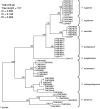Less-frequent Fusarium species of clinical interest: correlation between morphological and molecular identification and antifungal susceptibility
- PMID: 19321723
- PMCID: PMC2681829
- DOI: 10.1128/JCM.02467-08
Less-frequent Fusarium species of clinical interest: correlation between morphological and molecular identification and antifungal susceptibility
Abstract
Forty-eight Fusarium isolates morphologically identified as belonging to seven species of clinical interest (i.e., Fusarium chlamydosporum, Fusarium dimerum, Fusarium incarnatum, Fusarium napiforme, Fusarium nygamai, Fusarium proliferatum, and Fusarium sacchari) were characterized molecularly by the analysis of the sequences of the TUB region of the beta-tubulin gene. F. chlamydosporum and F. dimerum were the most genetically heterogeneous species. A high degree of correlation between the morphological and molecular identification was shown among the isolates studied. A table with the key morphological features for the identification of these Fusarium species is provided. The antifungal susceptibilities of the Fusarium isolates to 11 antifungal drugs were tested; terbinafine was the most active drug against all the species tested with the exception of F. incarnatum, for which amphotericin B was the most active.
Figures
References
-
- Alastruey-Izquierdo, A., M. Cuenca-Estrella, A. Monzón, E. Mellado, and J. L. Rodríguez-Tudela. 2008. Antifungal susceptibility profile of clinical Fusarium spp. isolates identified by molecular methods. J. Antimicrob. Chemother. 61805-809. - PubMed
-
- Azor, M., J. Gené, J. Cano, D. A. Sutton, A. W. Fothergill, M. G. Rinaldi, and J. Guarro. 2008. In vitro antifungal susceptibility and molecular characterization of clinical isolates of Fusarium verticillioides (F. moniliforme) and Fusarium thapsinum. Antimicrob. Agents Chemother. 522228-2231. - PMC - PubMed
-
- Balajee, S. A., A. M. Borman, M. E. Brandt, J. Cano, M. Cuenca-Estrella, E. Dannaoui, J. Guarro, G. Haase, C. C. Kibbler, W. Meyer, K. O'Donnell, C. A. Petti, J. L. Rodriguez-Tudela, D. Sutton, A. Velegraki, and B. L. Wickes. 2009. Sequence-based identification of Aspergillus, Fusarium, and Mucorales in the clinical mycology laboratory: where are we and where should we go from here? J. Clin. Microbiol. 47877-884. - PMC - PubMed
Publication types
MeSH terms
Substances
Associated data
- Actions
- Actions
- Actions
- Actions
- Actions
- Actions
- Actions
- Actions
- Actions
- Actions
- Actions
- Actions
- Actions
- Actions
- Actions
- Actions
- Actions
- Actions
- Actions
- Actions
- Actions
- Actions
- Actions
- Actions
- Actions
- Actions
- Actions
- Actions
- Actions
- Actions
- Actions
- Actions
- Actions
- Actions
- Actions
- Actions
- Actions
- Actions
- Actions
- Actions
- Actions
- Actions
- Actions
- Actions
- Actions
- Actions
- Actions
- Actions
LinkOut - more resources
Full Text Sources
Medical


